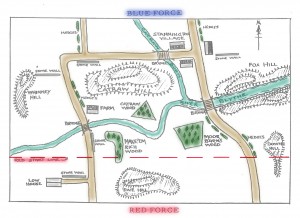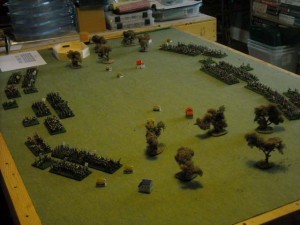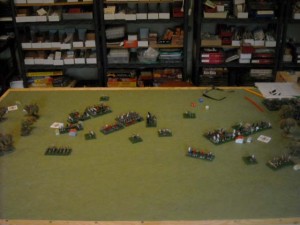It never fails. Whenever I jot down a list of war game projects it seems that very shortly thereafter I’m distracted from my list by some bright shiny game project! Such was the case late last week. I had recently picked up a copy of The Best of The Dragon. Sitting by the fire I picked up the copy and began to read. The first articles were nice pieces on Metamorphosis Alpha. A game we played when it came out; one that we played, but didn’t sink too much time into. As such the articles were a nice reminder of an old game. There were numerous articles on Dungeons & Dragons (D&D), but it was an article by Gary Gygax (On Dungeons & Dragons) that captured my attention. In a nutshell it was about the origins of original Dungeons & Dragons (OD&D) . No article covering the beginning of D&D can be written that doesn’t touch on the connection between Chainmail and D&D. It was the mention of Chainmail that was my distraction.
As may be known, Chainmail is one of my obsessions. OK, maybe it isn’t all that bad. It is however one of my favorites and it is really easy to get lost in reading and planning war games using the rules. That is exactly what happened. A quick trip out to the game room; to return with my well read copy of 3rd edition (sadly, my copies of 1st & 2nd editions are still missing – missing since the move from California). The next next task was to grab my Kindle and load up the PDF version I have (I wish Wizards of the Coast would make that available again). Armed with two copies of the rules I began to read (two copies make it very easy to look at text on one page and refer to tables and such on another page). This reading reminded me that I had a retyped version of the Geneva Medieval Miniatures rules from the April 1970 issue of Panzerfaust. I originally retyped these back in the late 1970’s as my copy of the April 1970 issue was in very, very sad shape and I really liked the rules. The typed pages were forgotten for many years, but at some point in the late 1990’s I retyped them into a plain text document/file and added them to my archives. Again the file was forgotten until a year or so ago, when I was working on another post concerning Chainmail (not yet published, as it needs some more work). OK, so to get back on point, I rooted around and found my text file and began to reformat it. The goal being to save as a PDF that I could keep on my Kindle and use as a reference when studying the rules.
Rules review more or less complete I started to think on what type of game I could set up, given my currently painted figures. About the only 25/28mm [suitable] figures I have make up my Norse army for Warhammer Fantasy Battle (WHF) – and yes, this army dates back to when the Norse were a real and supported army. Since these are mostly old Citadel Miniatures historical figures they will work just fine for a Viking themed game. I can add similarly themed figures to these from my miscellaneous Scruby and Bloodaxe figures. I do have some 54mm plastic knights and such. I even have a castle! Not sure I have enough figures in 54mm, but perhaps the man-to-man rules could be used for a small skirmish game. The other possibility that came to mind is that I have numerous painted 15mm figures. Mostly these are based for De Bellis Multitudinis (DBM) and for the most part are gathering dust. Perhaps a few tweaks for distance/range and these figures could be pressed into service? I will have to think about this, but it seems very do-able.
Now that I know what I have handy in the way of miniatures it is time to seriously think about some scenarios. Of course I can always just ‘do’ a standard meeting engagement type scenario. Or just borrow from one of my (many) copies of WHF – there are always a few nice scenario suggestions to be found in these rules books. In any event, I’ll look to use balanced forces for the first few games and see where things go from there.
My Chainmail adventure has caused my previous (unpublished) post to float to the surface and with my current level of energy I may be able to finish the article before too much longer. Perhaps as soon as I receive (should be in the mail on its way to me in the next couple of days) the last of the research materials I need to complete the article? We shall see how much new information I uncover.
Look for more Chainmail related news in the coming days.



